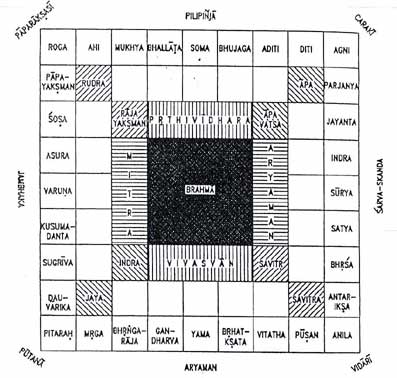THE ASTRONOMY OF THE AGE OF
GEOMETRIC ALTARS

The
temple platform
It also
raises he question of an analysis of the altars and monuments
from Babylon, Greece and Rome to examine their designs. Likewise,
the references in the Greek literature to geometric problems
related to areas need to be investigated further for their astronomical
significance.
Later religious
architecture, both in the east and the west, became more abstract
but its astronomical inspiration was never hidden. In Europe
cathedrals were a repesentation of the vault of heavens. In
India the temple architecture, as spelt out in the manuals of
the first centuries AD (see, for example, Kramrisch 1946), symbolizes
the sky where in addition to equivalence by number or area,
equivalence by category was considered. The temple platform
was divided into 64 or 81 squares (Fig. 2). In the case of the
64- squared platform, the outer 28 squares represented the 28
lunar mansions of the Indic astronomy. For the 81-squared platform,
the outer 32 squares were taken to represent the lunar mansions
and the four planets who rule over the equinoxial and solstitial
points. Stell Kramrisch, the renowned scholar of the Indian
temple architecture, has also argued that another measure in
the temple was that of 25920, the number of years in the period
of the precession of the equinoxes. Whether the precessional
figure was received by the Indians from the Greeks or obtained
independently in not clear.
The astronomer
Subhash C. kak – Q.J.R. Astrological Society (1995) 36
–p.385-395
|